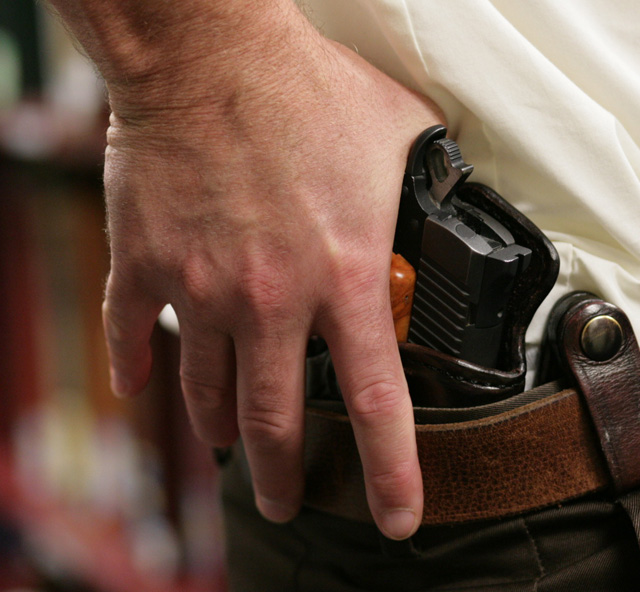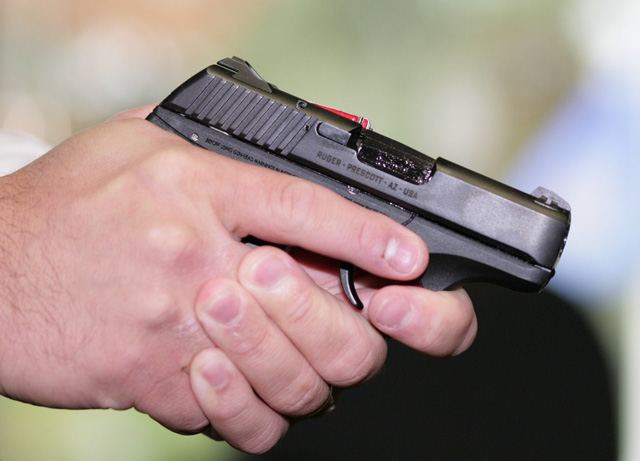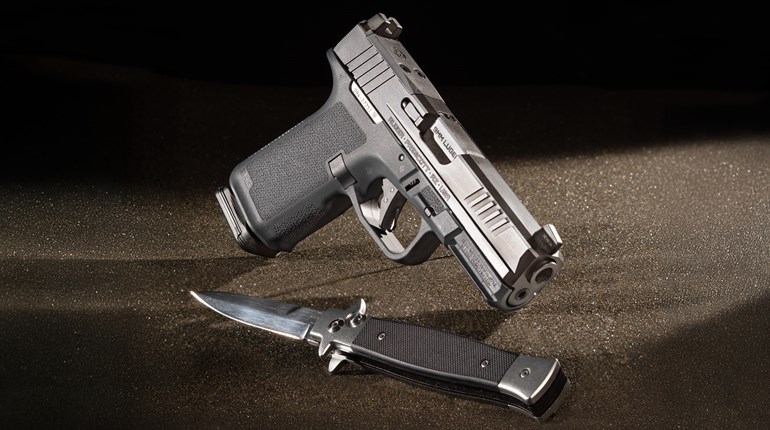
We don't have that luxury. Predators look the same as everyone else. Despite their common appearance, however, one aspect gives them away—their behavior. Once you learn what to look for, you'll be able to recognize a potential threat in order to avoid it or respond accordingly through awareness.
For those who think communication is predominately verbal, think again. Intent is communicated in three different ways. According to Protective Strategies' owner Randy LaHaie, "Seven percent of your ability to interpret that intent is based on words, thirty eight percent through voice and a whopping fifty five percent is projected through body language."
Therefore, developing a better understanding of body language is a valuable addition to your self-defense-related arsenal. Consider this: In the wild, predators don't typically pounce on the first thing they see. The same can be said for their bipedal equivalent. An evaluation process occurs, where predator assesses prey—determining their "victim potential." In doing so, they unknowingly project their intentions when they size a potential victim up, study their would-be prey from a distance, even test their defenses. Understanding this process gives you a proverbial leg up, enabling you to detect predatory behavior before the wolf strikes.

However, awareness can also serve as a deterrent to an attack. Predators typically prefer victims who are unaware of their surroundings or show little interest with regard to their personal safety.
Awareness, like playing poker well, requires an ability to read people and situations. The difference is, awareness enables you to anticipate the probability of potential violence. Moreover, it calls attention to safety-related aspects nearby.
Far from something you just turn on and off, one of the most beneficial aspects of awareness deals with the fact it can be used in varying degrees. As such, the level typically corresponds to your circumstances in a given moment. Naturally, as circumstances and surroundings change your awareness changes. For example, you'd want a keener level of awareness while crossing a deserted parking garage alone as opposed to being in a crowded movie theater with friends.
To better illustrate these varying levels and how they apply to self-defense, Col. Jeff Cooper taught awareness through a color code in an effort to demonstrate the various states of awareness as they pertain to "fight or flight." His color code is well known largely due to his founding of the American Pistol Institute, Gunsite and through his extensive writing on all manners of self-defense and tactics.
Condition white denotes being totally unaware of what's going on around you, such as when you're asleep. Conversely, yellow is a guarded state of awareness, in which you realize a potentially dangerous situation can occur at any time. You are prepared to respond accordingly—when and if it is warranted. Cooper claimed, and rightfully so, it is possible to live comfortably in condition yellow, cautious of your surroundings and of those therein.
While some may be quick to condemn this as paranoia, it's far from it. Instead, awareness is a state of relaxed alertness, capable of being assimilated into your character. Without it, you'd go through life in fear, peering into every corner or shadow with trepidation. Perhaps the best description of condition white I've come across comes from author Walt Rauch, in his book "Real-World Survival! What Has Worked For Me!" where he writes, "A better description of condition yellow is that you simply take a fresh and skeptical look at everything every time you look at it." He urges you to fight making assumptions, such as thinking your home is just the same way you left it when you return at the end of the workday. They not only prevent us from taking a good look at our surroundings, they can be fatal if you allow them to dictate your actions.
Although a simple solution, Rauch suggests learning to observe everything through the eyes of a baby—without the obscuring burden of assumption. Learning to do so will enhance your observation, by enabling you to see potential threats that may be unperceived otherwise.

Your level progresses to condition orange the moment a potential threat appears. In this heightened state of awareness, your mind begins to develop a response. Returning to the example of crossing a deserted parking garage alone, one possible example of a progression to condition orange would be discovering someone is following you. Whether you choose to confront the person, make it to your vehicle or find the nearby refuge, the threat potential is high and must be handled quickly.
Since receiving my concealed-carry permit more than 10 years ago, I've found myself in condition orange twice, the most hair-raising of which involved my good friend Beau and I going to his girlfriend's for dinner and a movie. Not the best of neighborhoods, Beau explained that April's apartment complex had been the subject of more than one drug raid by police in previous weeks. Although I wish my friend had shared this tidbit of information prior to my agreeing to accompany him, I took comfort in knowing he too, was carrying concealed.
Upon our arrival, Beau pulled his pick-up truck alongside the staircase leading to April's apartment long enough to grab my wheelchair from the back, whereby I transfered from the vehicle to my chair and waited while he found a parking spot over in the visitor's lot.

With the bleak outlook of making the steep trek (in the oppressive summer heat) up the more than 20 stairs leading to April's apartment, I often used the brief respite to mentally steel myself for yet another Everestesque ascent—not to mention the thought of the frosty beverage that always awaited me inside.
My thoughts were pulled away from the climb when I spotted two 20-somethings walking nearby, dressed like they were on their way to a gang-banger's convention. However, even more of a cause for alarm concerned the pit bull being walked at the end of a very long leash. They spotted me the moment I caught sight of them, and sure enough, a course correction followed. The next thing I knew, canine and company were heading straight for me at a leisurely but purposeful clip. In an attempt to amp up the intimidation factor, the guy handling the dog continually added slack to the leash with nearly every step he took.
Realizing this was about to get ugly, I quartered myself toward them and began backing my wheelchair up, to just to the other side of the staircase. While it wasn't much of an obstacle between me the assailants, being just a few feet away it was the closest barrier I could get to. With the assailants about 20 yards away and closing, I eased the pack open holding my Smith & Wesson Model 645. Still, I had to give them the benefit of the doubt. Dogboy could have just been showing off for his friend. After two more steps, I would tell them to back off. Then, if they let go of the leash, I would draw and take aim on the most-immediate threat—the dog. Thankfully, I didn't have to. Just as I was about to shout my warning, the sound of a tin can being kicked across the parking lot caught everyone's attention, and sight of Beau trotting toward me made the assailants decide to find entertainment elsewhere.
Needless to say, we both breathed a sigh of relief when we got inside. Moreover, we had an extra laugh when Beau told me he found it odd how I was turning my chair. That's when he caught sight of the dog's proximity to me—not to mention my hand's proximity to my pistol. It turns out he kicked the can to draw their attention and let me know he had my back.
Just because the assailants didn't have any weapons visible didn't mean there wasn't a threat present. Quite the contrary, the presence of a pit bull, and especially the way it was being handled, made the threat obvious. That realization escalated my awareness to condition red. Short of verbally drawing a line in the sand and hoping the assailants would comply, I had no way out of the situation. As a result, I was forced to prepare for the threat and respond accordingly (Cooper protégé Clint Smith, director of Thunder Ranch has since added condition black to indicate when the appropriate response to a threat escalates to a gunfight).
What justifies elevating your level of alertness from condition orange to red? In order to act quickly, you must have a predetermined action in mind. Though it can be any number of things, this "mental trigger" must be sufficient enough to justify lethal response. Colonel Cooper described it best in "To Ride, Shoot Straight, and Speak the Truth" when he wrote, "Most usually it will be a shot fired at him, but it can be a weapon pointed at him or a weapon pointed with lethal intent at someone else. In any case, it must be fixed upon in advance so that there is no need to hold a conference with oneself at the moment of truth." In my instance, the weapon in question was the dog. Everything hinged on whether its owner let go of the leash and commanded the pit bull to attack.
While knowing about the difference types of awareness is one thing, knowing what to pay attention to and customizing to match your circumstances not only requires a "mental map," it's a topic for a different time.





































